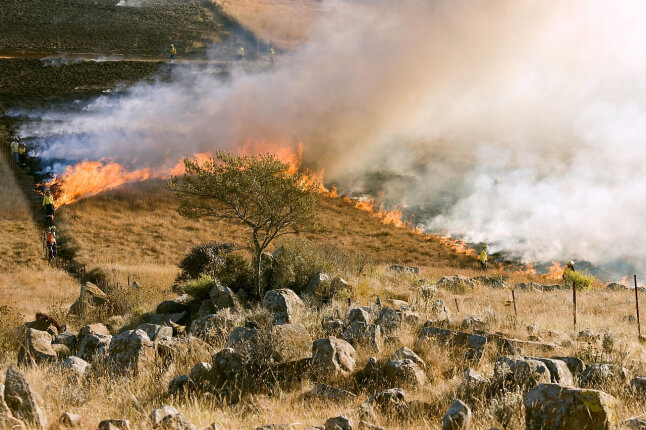News
Key Takeaways
-
Harvard-led researchers found that increases in fine particulate pollution (PM2.5) from 2020 wildfires in California, Oregon, and Washington may have contributed to 19,700 COVID-19 cases and 750 deaths.
-
Statistical models combining satellite smoke data and ground-based PM2.5 measurements showed that wildfire days had significantly higher particle levels, amplifying COVID-19 transmission and mortality up to four weeks after exposure.
-
The findings highlight how climate change–driven wildfire trends can worsen respiratory disease outcomes, compounding public health crises like the COVID-19 pandemic.
Thousands of COVID-19 cases and deaths in California, Oregon, and Washington between March and December 2020 may be attributable to increases in fine particulate air pollution (PM2.5) from wildfire smoke, according to a new study co-authored by researchers at Harvard University.
The study is the first to quantify the degree to which increases in PM2.5 pollution during the wildfires contributed to excess COVID-19 cases and deaths in the U.S. It is published in Science Advances.
“The year 2020 brought unimaginable challenges in public health, with the convergence of the COVID-19 pandemic and wildfires across the western United States. In this study we are providing evidence that climate change—which increases the frequency and the intensity of wildfires—and the pandemic are a disastrous combination,” said Francesca Dominici, Clarence James Gamble Professor of Biostatistics, Population and Data Science at the Harvard T.H. Chan School of Public Health and senior author of the study.
The year 2020 brought unimaginable challenges in public health, with the convergence of the COVID-19 pandemic and wildfires across the western United States.
In 2020, at the same time the nation was contending with the COVID-19 pandemic, huge wildfires swept across the western U.S., including some of the largest ever in California and Washington. Wildfires produce high levels of fine particulate matter (PM2.5), which has been linked with a host of negative health outcomes, including premature death, asthma, chronic obstructive pulmonary diseases (COPD), and other respiratory illnesses. In addition, recent studies have found a link between short- and long-term exposure to PM2.5 and COVID-19 cases and deaths.
The researchers — from Harvard Chan School, the Harvard John A. Paulson School of Engineering and Applied Sciences (SEAS), the Department of Earth and Planetary Sciences at Harvard, and the Environmental Systems Research Institute in Redlands, Calif.—built and validated a statistical model to quantify the extent to which wildfire smoke may have contributed to excess COVID-19 cases and deaths in California, Oregon, and Washington, three states that bore the brunt of the 2020 wildfires. They looked at the connection between county- and daily-level data on PM2.5 air concentrations from monitoring data, wildfire days from satellite data, and the number of COVID-19 cases and deaths in 92 counties, which represented 95% of the population across the three states. The researchers accounted for factors such as weather, population size, and societal patterns of social distancing and mass gatherings.
The researchers relied on satellite data of smoke plumes to identify the locations and days affected by wildfires.
“By combining satellite data with ground measurements of total PM2.5, we could more confidently distinguish smoke from other types of particles,” said co-author Tianjia (Tina) Liu, a fifth-year graduate student in the Department of Earth and Planetary Sciences, who led the validation of the satellite data.
The study found that from August 15 to October 15, 2020, when fire activity was greatest, daily levels of PM2.5 during wildfire days were significantly higher than on non-wildfire days, with a median of 31.2 micrograms per cubic meter of air (µg/m3) versus 6.4 (µg/m3). In some counties, the levels of PM2.5 on wildfire days reached extremely high levels. For instance, from September 14 to September 17, 2020, Mono County, Calif., experienced four days in a row with PM2.5 levels higher than 500 µg/m3 as a result of the Creek Fire. Such levels are deemed “hazardous” by the U.S. Environmental Protection Agency.
Wildfires amplified the effect of exposure to PM2.5 on COVID-19 cases and deaths, up to four weeks after the exposure, the study found. In some counties, the percentage of the total number of COVID-19 cases and deaths attributable to high PM2.5 levels was substantial.
On average across all counties, the study found that a daily increase of 10 µg/m3 in PM2.5 each day for 28 subsequent days was associated with an 11.7% increase in COVID-19 cases, and an 8.4% increase in COVID-19 deaths. The biggest effects for the COVID-19 cases were in the counties of Sonoma, Calif., and Whitman, Wash., with a 65.3% and 71.6% increase, respectively. The biggest effects for the COVID-19 deaths were in Calaveras, Calif., and San Bernardino, Calif., with a 52.8% and 65.9% increase, respectively.
Given projections of rising temperatures under climate change, the current trend of increasing fires in the West is likely to continue, with consequences for respiratory diseases such as COVID-19.

Across the three states studied, the cumulative number of COVID-19 cases and deaths attributable to daily increases in PM2.5 from wildfires was, respectively, 19,700 and 750, the study found.
“Given projections of rising temperatures under climate change, the current trend of increasing fires in the West is likely to continue, with consequences for respiratory diseases such as COVID-19,” said co-author Loretta J. Mickley, Senior Research Fellow at SEAS. “Warmer temperatures dry out vegetation, which then becomes fuel for fire. Just this week, the Intergovernmental Panel on Climate Change named the western United States as one of several regions likely to experience enhanced fire activity in future decades.”
Co-first authors of the study were Xiaodan Zhou of the Environmental Systems Research Institute and Kevin Josey from the Department of Biostatistics at Harvard Chan School. Leila Kamareddine of the Department of Biostatistics at Harvard Chan School also contributed, as did Miah C. Caine from SEAS.
Funding for the study came from the Environmental Protection Agency (grant 83587201-0), the National Institutes of Health (grants R01ES026217, R01MD012769, R01ES028033, 1R01AG060232-01A1, 1R01ES030616, 1R01AG066793-01R01, 1R01ES029950, and 5T32ES007142), the Alfred P. Sloan Foundation, and the Vice Provost for Research-Harvard University.
Wildfire research developments
Follow the evolution of wildfire research at Harvard SEAS at this link.
Topics: Climate, COVID-19, Environment, Health / Medicine, Research, Wildfire
Cutting-edge science delivered direct to your inbox.
Join the Harvard SEAS mailing list.
Scientist Profiles
Loretta J. Mickley
Senior Research Fellow in Chemistry-Climate Interactions
Press Contact
Leah Burrows | 617-496-1351 | lburrows@seas.harvard.edu



